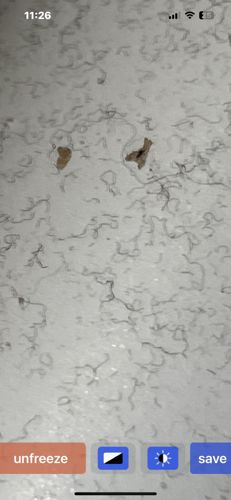Threadworm (likely a type of Nematode)
Scientific Name: Phylum Nematoda (specific genus/species cannot be determined from the image alone)
Order & Family: Order: Rhabditida (common for free-living nematodes), Family: Varies widely, as there are many families within Nematoda. Without microscopic examination, it's hard to be specific.
Size: Typically microscopic to a few millimeters in length, making them barely visible to the naked eye as thin threads. The organisms in the image appear to be in the millimeter range.

Natural Habitat
Based on the appearance of the image, showing many thin, wiggly organisms on a surface that appears moist or wet, these are likely free-living nematodes or threadworms. They thrive in damp environments such as soil, freshwater, marine sediments, and even in moist indoor environments like bathrooms or basements where conditions are suitable for microbial growth.
Diet & Feeding
Most free-living threadworms (nematodes) feed on bacteria, fungi, algae, and detritus found in their environment. Some parasitic forms feed on host tissues or bodily fluids.
Behavior Patterns
Threadworms have a simple life cycle that involves molting through several larval stages before reaching adulthood. They are known for their rapid reproduction, especially in moist and warm environments. Their movement involves undulating or 'snaking' motions.
Risks & Benefits
Generally, free-living nematodes are harmless to humans and are crucial for ecosystem health by playing a vital role in nutrient cycling and decomposition. They are part of the soil food web. However, if these are parasitic nematodes (which is less likely given the environment appears to be a surface rather than inside a host), they can pose health risks to humans, animals, or plants. The conditions favorable for their growth (dampness) can also promote mold or bacterial growth, which might be a concern.
Identified on: 9/2/2025